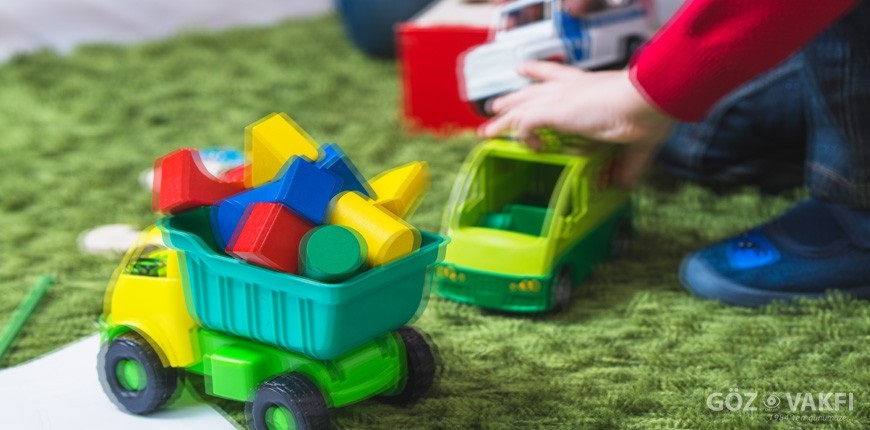
What is Strabismus?
It is the loss of the alignment of the two eyes in parallel. Each eye has six extraocular muscles. Gliding in the eyes is caused by either too little or too much strength in one or more of them. One eye may be straight ahead, while the other may be turned upward, outward, or downward. Slippage can occasionally be seen in both eyes.
Depending on the underlying cause, strabismus may be permanent or only intermittent. About 4% of people have strabismus, and both boys and girls experience it on an equal basis.
What Are Strabismus Symptoms?
Eyes that have lost their parallelism.
Watering eyes and eye pain.
Loss of three-dimensional vision, double vision, blurry vision.
One can count the number of head or face turns to one side, upturned chins, head tilts forward, and raised eyes.
What are the Symptoms of Adult Strabismus?
Double vision is the most typical symptom of strabismus in older age groups.
Eye pain, headaches, and persistent head tilting are just a few possible symptoms.
Outwardly deviant children and adults prefer to cover one eye in direct sunlight.
What are the Strabismus Risk Factors?
Those who have a history of premature birth, strabismus in the family.
Those who had a febrile convulsive illness when they were young Those who had consanguineous marriages.
Those with a background in trauma (falling from a height, hitting their head)
problematic time of pregnancy.
What methods are used to diagnose and examine strabismus?
Assessment of vision. For kids between the ages of 6 months and 4 years old, our hospital uses a special pediatric refraction unit called the Plus Optix device.
Determining the initial degree change in the eye direction and when it began, also using a synoptophore and prisms to determine the degree of the change.
Hess curtain examination: It is crucial in cases of strabismus caused by paralysis of the eye muscles.
The Hirshberg test measures the amount of deviation in patients without fixation in the corneal light reflex.
Examining stereopsis to determine depth perception (three-dimensional vision).
Early Diagnosis in Childhood
It is crucial to have the first exam at the earliest possible age, as early as one year old.
Early diagnosis and initiation of treatment are possible for eyelid drooping and nystagmus during this time.
Within two to three months, vision loss with a permanent nature can be brought on by congenital cataracts, congenital glaucoma, or retinal conditions.
Particularly for the identification and management of strabismus, examination between the ages of 6 months and 1 year is of utmost importance. After six months, continuing shifts unavoidably call for treatment.
Exams are crucial at ages 3 to 4 and during the preschool years, even if there are no complaints in the later period.
The Treatment for Strabismus
Optical Treatment: Some cases of strabismus can be treated with glasses because they are caused by refractive errors.
Orthoptic Exercises: It is done with both eyes to improve vision and depth perception.
Medical Care: Mydriatic and miotic medication is used in the treatment.
Surgery: The goal of the procedure is to correct the deviation, provide binocular single vision, and produce a pleasing aesthetic result.
It is used for slips that develop from birth or later but can't be fixed with glasses.
How Does Strabismus In Adults Get Treated?
Eye Exercises: Eye exercises are used to treat specific conditions like convergence insufficiency, which can occur when reading or when the eye is not working as hard as it should while working.
Prism Glasses: These are used to treat slight shifts. Eliminates double vision.
Injection (botulinum toxin): It is based on the administration of a substance that, when injected into a muscle, temporarily paralyzes it. In some circumstances, it is a helpful technique.
Surgery: At all ages, surgery is the most frequently employed form of treatment. It may be carried out under local anesthesia in suitable circumstances. Surgery can be done for aesthetic purposes, to lessen double vision, to make sure that both eyes are used simultaneously, and to ease eye pain.
What is Amblyopia/Lazy Eye?
A 20% or greater decline in visual acuity in either one or both eyes is referred to as amblyopia in medical terminology. Its prevalence in the population ranges from 2 to 4%.
The brain begins to develop the ability to see at birth. Lazy eye may appear during infancy and childhood, when vision develops quickly if there is a defect in the transmission of visual stimulus to the brain as a result of some congenital or acquired eye disorders (cataract, strabismus, high eye disorder, etc.). Binocular vision (using both eyes together) and the prevention of amblyopia are crucial, especially in the first two years when the nervous system is still malleable. Therefore, the results can be improved the earlier the treatment is initiated. Before the age of three, everyone should have a thorough eye examination by an ophthalmologist, especially those with a family history of strabismus or lazy eye. However, routine eye exams by an ophthalmologist are necessary for everyone at the latest 3–4 years of age, even if there are no complaints or risk factors.
How is the treatment for lazy eyes conducted?
Treatment for lazy eyes must focus on the underlying causes. First, vision-impairing conditions like droopy eyelids and cataracts need to be treated. Other medical options include:
Treatment with glasses: Refractive errors in the eyes, which frequently contribute to lazy eyes, should be fixed with glasses and, if necessary, contact lenses. In most instances, this straightforward strategy is adequate.
Closure procedure (complete or partial): It is based on the well-seeing eye's complete or partial closure. According to recent research, the 3–7 age range typically requires 6 hours of closure for advanced amblyopia and 2 hours for mild–moderate amblyopia. The effectiveness of closure therapy is increased by targeting nearby targets. Up until the age of 12, most kids react favorably to closure.
Penalization treatment: It is divided into two categories: atropine penalties and optic penalties. To achieve this, 2-3 mornings per week, 1 drop of 1% atropine is injected into the well-sighted eye. Even though the near vision is improved with the addition of + glass in the amblyopic eye, the refractive error of the patient's eye is only partially corrected in the healthy eye.
CAM therapy: Every day of the week, it is used in ten sessions in the hospital setting. It is used in our hospital as well. According to studies, CAM treatment produces visual outcomes that are comparable to those of conventional occlusion and close-range manipulations.
Until What Age Should Lazy Eye Treatment Be Continued?
Even if amblyopia treatment results in full vision in both eyes, amblyopia may return once the treatment is stopped. Because of this, amblyopic children should be monitored until they are between the ages of 10 and 12 and, if necessary, should receive maintenance therapy (for vision protection).
What is Irrigation Tear Obstruction?
The stenosis or obstruction of the tear ducts is the most typical cause of eye watering and burring. Inflammatory fluids leak from the hole made on the eyelid when the nose's base is pressed. In the first year, this situation causes distress for the parents, but typically at the end of this time, the channel opens and the child's complaints stop. Massage to the root of the nose and antibiotic drops are advised during burr periods in order to help the canal open during this time.
The probing procedure can be carried out while under general anesthesia if the canal has not been opened after a year. If this procedure doesn't work the first time, try it again. After the age of 3–4 years, however, surgical intervention is necessary if the canal is not opened.
You can get in touch with our hospital to discuss any number of eye health-related issues, receive thorough information about your specific eye issues, and discover the course of treatment.





